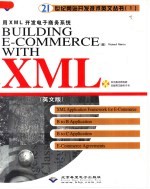图书介绍
用XML开发电子商务系统 BUILDING E-COMMERCE OITH XML2025|PDF|Epub|mobi|kindle电子书版本百度云盘下载

- (美)Richard Martin文本著作者 著
- 出版社: 北京:北京希望电子出版社
- ISBN:790005636X
- 出版时间:2001
- 标注页数:258页
- 文件大小:26MB
- 文件页数:267页
- 主题词:
PDF下载
下载说明
用XML开发电子商务系统 BUILDING E-COMMERCE OITH XMLPDF格式电子书版下载
下载的文件为RAR压缩包。需要使用解压软件进行解压得到PDF格式图书。建议使用BT下载工具Free Download Manager进行下载,简称FDM(免费,没有广告,支持多平台)。本站资源全部打包为BT种子。所以需要使用专业的BT下载软件进行下载。如BitComet qBittorrent uTorrent等BT下载工具。迅雷目前由于本站不是热门资源。不推荐使用!后期资源热门了。安装了迅雷也可以迅雷进行下载!
(文件页数 要大于 标注页数,上中下等多册电子书除外)
注意:本站所有压缩包均有解压码: 点击下载压缩包解压工具
图书目录
PART ONE Introduction to e-business,and XML1
CHAPTER 1 XML and e-business applications2
1.1 About e-business3
1.1.1 Business transformation and innovation5
1.1.2 Which is the e-business value?7
1.1.3 A simplified classification schema for e-business applications7
1.2 The Extensible Markup Language(XML)13
1.2.1 World Wide Web document standards14
1.2.2 A brief history of XML14
1.2.3 XML-a universal data format15
1.2.4 A short comparison of XML and HTML16
1.2.6 Advanced type definitions18
1.2.7 Metadata(RDF and PICS)18
1.2.5 XML linking and addressing18
1.2.8 Domain-specific document definitions19
1.2.9 XML in wireless apphcations20
1.2.10 XML styling and transcoding21
1.2.11 XML query languages21
1.2.12 Processing XML documents22
1.2.13 Organizations concerned with XML25
1.2.14 Typical applications26
1.3 XML and e-business27
1.4 Summary29
CHAPTER 2 Introduction to IBM e-business solutions30
2.1 IBM e-business cycle31
2.2 IBM Application Framework for e-business33
2.2.1 Using an asset-based approach34
2.2.2 Overview of the IBM Application Framework37
2.2.3 Patterns for e-business45
2.3 Summary50
CHAPTER 3 XML in the IBM Application Framework for e-business53
3.1 e-business application with XML53
3.2 IBM XML development tools and utilities56
3.2.1 Open source initiative:the xml.apache.org project58
3.2.2 Parsers60
3.2.3 Editing61
3.2.4 Formatting66
3.2.5 Programming69
3.3 XML open frameworks73
3.3.1 OASIS consortium,XML.ORG73
3.3.2 Electronic Business XML initiative(ebXML)74
3.3.3 WebSphere B2B Integrator75
3.4 XML extensions to IBM products78
3.4.1 WebSphere Application Servers79
3.4.2 VisualAge for Java85
3.4.3 MQSeries Integrator85
3.4.4 DB2 XML Extender86
3.4.5 Lotus with XML88
3.4.6 Tivoli Cross-Site90
3.5 Summary91
PAPT TWO Designing B2C and B2B e-business applications using XML92
CHAPTER 4 Patterns for B2C and B2B applications94
4.1 Definitions95
4.1.1 Logical and physical patterns95
4.1.2 Runtime topology nodes96
4.2 e-business patterns for B2C applications98
4.2.1 B2C logical patterns for e-business98
4.3 e-business patterns for B2B applications103
4.3.1 B2B logical patterns for e-business104
4.3.2 Physical patterns for B2C and B2B runtime topologies112
4.4 Implementation considerations for XML113
4.4.1 Applications that benefit from using XML114
4.4.2 Typical design for applications using XML115
4.4.3 A sample of an architecture for XML applications116
4.4.4 Composing Java object with XML118
4.4.5 XML filtering with Java servlets119
4.4.6 XML/XSL as inputs for a Web application generator119
4.4.7 Performance119
4.4.8 Security120
4.5 Summary120
CHAPTER 5 B2C applications using XML122
5.1.1 The field of business-customer interaction123
5.1 The B2C application model123
5.1.2 Application models,architectures and compoents124
5.1.3 XML powers the B2C interaction127
5.2 Enterprise portals128
5.2.1 Data and application integration129
5.2.2 Content management131
5.2.3 Controlled access to structured information133
5.2.4 Customer relations,recognition,and personalization134
5.2.5 Business intelligence and enterprise portals137
5.2.6 Connection to e-commerce138
5.2.7 New presentation devices141
5.2.8 IBM portal examples143
5.3 IBM products and tools in B2C applications146
5.3.1 Enterprise Information Portal146
5.3.2 Lotus Raven suite148
5.3.3 IBM WebSphere150
5.3.4 IBM products and tools in portals153
5.4 Summary154
CHAPTER 6 B2B applications using XML156
6.1 The B2B application model157
6.1.1 B2B:a major business opprtunity of business integration158
6.1.2 General issues in business-to-business electronic interactions159
6.1.3 XML B2B frameworks and standards160
6.2 IBM WebSphere B2B Integrator164
6.2.1 Trading Partner Agreements164
6.2.2 The IBM Business-to-business Protocol Framework181
6.2.3 A sample application TPA187
6.2.4 Using the IBM Visual XML Builder for a specific OBI TPA190
6.3 Summary207
PART THREE B2B eMarketPlaces210
CHAPTER 7 B2B eMarketPlaces:a case study212
7.1 Why the B2B eMarketPlace application?213
7.2 eMarketPlaces and online intermediaries214
7.2.1 B2B online intermediary business trading models216
7.3 The E-broker application217
7.3.1 E-broker business models218
7.3.2 Considerations on the impact of XML on the architecture226
7.3.3 A building block architecture230
7.3.4 E-broker application functional decomposition232
7.4 Initial E-broker design activities238
7.4.1 E-broker access service TPAs238
7.4.2 The directory service data model in DB2 XML Extender241
7.5 Summary245
APPENDIX A An example of a OBI TPA XML document246
A.1 The OBI TPA between Large Coand pens We Are247